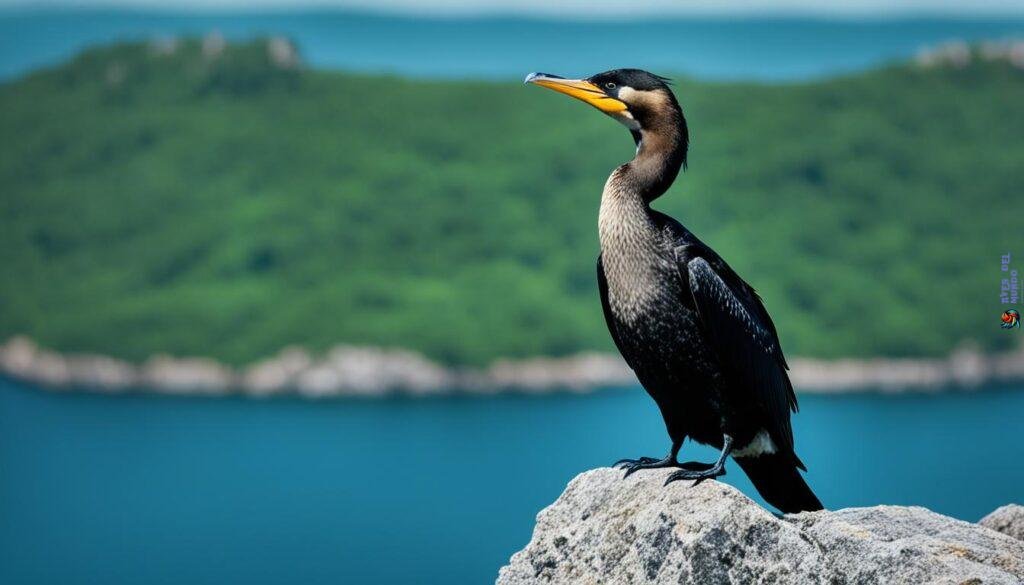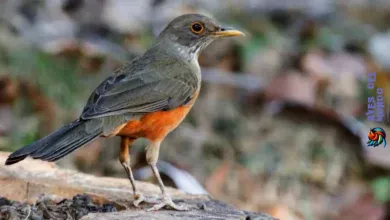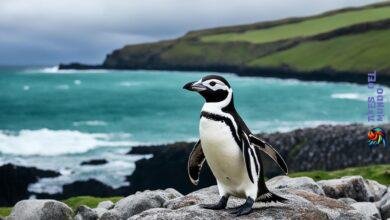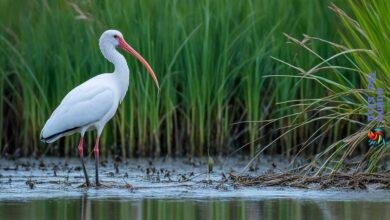Did you know that cormorants have a voracious appetite and can consume up to a pound of fish in a single day? These fascinating birds, belonging to the cormorant species, are renowned for their incredible diving abilities and unique characteristics. In this comprehensive guide, we will explore the cormorant facts, behavior, habitat, diet, and conservation efforts surrounding these captivating creatures. Whether you’re a bird enthusiast or simply curious about the wonders of the natural world, prepare to be amazed by the fascinating world of cormorant birds.
Physical Characteristics of Cormorant Birds
Cormorants, also known as cormorant birds, possess unique physical attributes that distinguish them from other avian species. These characteristics, including their appearance, plumage, and beak, enable them to thrive in their aquatic habitats.
Appearance
Cormorant birds have a distinct appearance that allows them to blend seamlessly with their surroundings. They exhibit long necks, hooked bills, and dark plumage, making them well-suited for life in aquatic environments.
Plumage
Their plumage, consisting of dense, waterproof feathers, plays a crucial role in their ability to maintain buoyancy while diving and swimming underwater. These feathers contribute to their sleek and streamlined bodies, enabling efficient movement through the water.
Beak
The beak of a cormorant is sharp and pointed, perfectly adapted for its diet and hunting techniques. With their beaks, cormorants can catch and grip fish effectively, facilitating successful hunting and feeding.
Webbed Feet
A notable feature of cormorants is their webbed feet, which aid in their swimming abilities. These specialized feet provide greater propulsion and maneuverability in the water, enabling cormorants to swim swiftly and pursue their prey with agility.
In summary, the physical characteristics of cormorant birds, including their appearance, plumage, beak, and webbed feet, are essential adaptations that allow them to thrive amid their aquatic habitats. These features combine to create a remarkable species that is well-suited for their unique lifestyle.
Cormorant Bird Habitat
Cormorant birds are highly adaptable creatures that can be found in a variety of habitats, both freshwater and saltwater. They have managed to populate different environments worldwide, showcasing their resilience and wide-ranging adaptability. Whether you’re exploring serene lakes, mighty rivers, picturesque coastal areas, or even remote islands, you may come across these remarkable birds.
Cormorants are particularly well-suited for aquatic habitats, and they thrive in both freshwater and saltwater ecosystems. Their sleek bodies and webbed feet make them excellent swimmers and divers, enabling them to navigate through various bodies of water with agility. They are often observed in areas with abundant fish populations, such as estuaries, marshes, and mudflats.
Their ability to inhabit diverse habitats, from freshwater lakes to coastal regions, contributes to their success as a species and underscores their adaptability to different environments. Cormorants are true aquatic marvels, perfectly adapted and thriving in the dynamic ecosystems they call home.

| Cormorant Bird Habitat | |
|---|---|
| Freshwater Habitat | Saltwater Habitat |
| 1. Lakes | 1. Coastal areas |
| 2. Rivers | 2. Estuaries |
| 3. Marshes | 3. Mudflats |
| 4. Ponds | 4. Islands |
Cormorant Bird Diet
Cormorant birds have a diverse and intriguing diet, focusing primarily on fish, but also incorporating aquatic invertebrates into their meals. Their natural instincts and physical adaptations enable them to be skilled hunters in both the air and underwater.
With their keen vision, cormorants can spot fish beneath the water’s surface, allowing them to successfully target their prey. Using their agile wings and feet, they navigate through the water with precision and speed, capturing fish with remarkable accuracy.
Cormorants employ various hunting techniques to secure their meals. They may swoop down from the air, plunging into the water to snatch fish near the surface. Alternatively, they exhibit impressive diving abilities, submerging themselves completely to catch fish below. During these underwater pursuits, cormorants can remain submerged for up to 60 seconds, relying on their exceptional breath-holding capacity.
Fish Consumption
Cormorants have a voracious appetite, capable of consuming large quantities of fish in a single day. Their diet primarily consists of various fish species, contributing to their status as expert fishermen. Cormorants rely on their exceptional diving and swimming abilities, as well as their sharp beaks, to catch fish effectively.
As apex predators, cormorants help maintain the equilibrium of aquatic ecosystems by controlling fish populations. They play a vital role in these habitats, regulating fish abundance and contributing to overall biodiversity.
Aquatic Invertebrates
In addition to fish, cormorants also incorporate aquatic invertebrates into their diet. These include small crustaceans and insects, which they find in their watery habitats. By expanding their menu to include these organisms, cormorants showcase their adaptability and resourcefulness in capturing available food sources.
The inclusion of aquatic invertebrates in their diet allows cormorants to access a broader range of nutrients, contributing to their overall health and survival.
Table: Cormorant Bird Diet Summary
| Primary Diet | Secondary Diet |
|---|---|
| Fish | Aquatic invertebrates |
Cormorant Bird Behavior
Cormorant birds are known for their fascinating behaviors, which set them apart from other avian species. From their incredible diving abilities to their social interactions, cormorant behavior is truly intriguing.
Diving Behavior
Cormorants are skilled divers and have developed a unique method of catching fish. Unlike other birds that snatch their prey from the water’s surface, cormorants plunge into the water and propel themselves through it using their agile wings and feet. This diving behavior allows them to efficiently hunt and capture fish beneath the water’s surface.
Social Behavior
Cormorants are social birds that often gather in large groups, called colonies. These colonies serve important purposes such as breeding, nesting, and roosting. The social behavior of cormorants contributes to their overall survival and reproductive success as a species.
Courtship Rituals
During the breeding season, male cormorants perform elaborate courtship rituals to attract females. These rituals involve displays of agility, strength, and vocalizations. By showcasing their desirable traits, male cormorants aim to impress and win the affections of the females within their colony.
Nesting Behavior
Cormorants build nests in colonies, constructing them out of twigs, grass, and other materials. The nests are typically located on cliff sides, trees, or the ground, depending on the available habitat. Cormorants are diligent nest builders, creating sturdy structures that provide a suitable environment for their eggs and young.
Here is a table that summarizes some of the key behaviors exhibited by cormorant birds:
| Behavior | Description |
|---|---|
| Diving | Cormorants dive underwater to catch fish, using their wings and feet for propulsion. |
| Socializing | Cormorants gather in colonies for breeding, nesting, and roosting. |
| Courtship | Male cormorants perform elaborate rituals to attract females during the breeding season. |
| Nesting | Cormorants build nests in colonies using twigs, grass, and other materials. |
The image above captures the essence of cormorant diving behavior, showcasing their remarkable agility and underwater prowess.
Cormorant Bird Distribution and Population
Cormorant birds have a widespread distribution, being found on every continent except Antarctica. They have successfully populated various habitats worldwide, including freshwater lakes and rivers, coastal areas, and remote islands.
Due to human activities and environmental changes, the global population of cormorants has been affected. However, recent years have shown promising signs of population recovery in certain regions. This recovery can be attributed to ongoing conservation efforts and habitat restoration projects.
Global Distribution of Cormorant Birds
Cormorant birds have managed to adapt and thrive in diverse environments across the globe. They can be found in various regions, each offering unique habitats and resources. Here are some notable areas where cormorants are commonly found:
- North America: Cormorants can be spotted along the coasts of the United States and Canada, as well as inland near bodies of water such as the Great Lakes.
- Europe: Cormorants are prevalent in many European countries, including the United Kingdom, France, and the Netherlands. They can be found along coastlines, rivers, and lakes.
- Asia: Cormorant populations are abundant in Asian countries such as China, Japan, and India. They are often found in both freshwater and coastal areas.
- Australia: Cormorants thrive in the diverse habitats of Australia, including coastal regions, rivers, and wetlands.
- Africa: Across the African continent, cormorants can be found near water bodies such as lakes, rivers, and estuaries.
- South America: Cormorant populations exist along the coasts of South American countries like Peru, Chile, and Argentina, as well as inland near lakes and rivers.
Population Recovery Efforts
The decline in cormorant populations has raised concerns and spurred conservation efforts to protect and rehabilitate these birds. Conservation organizations and governmental bodies have implemented measures such as:
- Protected Status: Many countries have designated cormorants as protected species, making it illegal to harm or disturb them.
- Reducing Human Impact: Regulations have been put in place to minimize the negative impact of human activities on cormorant populations, such as hunting and habitat destruction.
- Habitat Restoration: Restoration projects aim to create suitable environments for cormorants, rejuvenating their habitats and providing essential resources.
- Monitoring and Research: Continuous monitoring and research initiatives help assess population trends, identify threats, and develop targeted conservation strategies.
These collective efforts have contributed to the recovery of cormorant populations in specific regions, highlighting the importance of conservation in safeguarding these remarkable birds for future generations.
Cormorant Bird Conservation Efforts
Cormorant birds are a protected species in many countries due to their declining populations and vulnerability to various threats. Conservation efforts have been implemented to safeguard these birds and their habitats, ensuring their long-term survival.
Laws and regulations have been enacted to protect cormorants from human activities that pose risks to their populations. These measures include hunting restrictions and the preservation of critical habitats, preventing habitat destruction and disturbance.
Environmental threats, such as pollution and oil spills, are also significant concerns for cormorant populations. These hazards can have devastating effects on the birds and their ecosystems. Efforts are underway to mitigate these risks by implementing stricter regulations on industrial practices and promoting sustainable environmental practices.
Habitat restoration projects play a crucial role in the conservation of cormorant birds. By restoring and creating suitable habitats, conservationists aim to provide safe and optimal environments for cormorants to thrive. Restoration initiatives focus on improving nesting areas, enhancing fish populations, and preserving the natural balance of ecosystems.
To raise public awareness and promote active participation in cormorant conservation, educational programs and public outreach campaigns are organized. These initiatives aim to educate communities about the importance of protecting cormorants and their habitats, encouraging individuals to support and engage in conservation efforts.
Overall, the conservation efforts for cormorant birds are comprehensive and multifaceted, addressing various threats and challenges faced by these remarkable avian species. By implementing protective measures, mitigating environmental risks, and restoring habitats, we can work towards preserving cormorants for future generations to admire and appreciate.
Conservation Efforts for Cormorant Birds
| Conservation Initiatives | Description |
|---|---|
| Protected Species Status | Cormorants are legally protected in many countries, preventing hunting and ensuring their habitats remain undisturbed. |
| Regulation of Human Activities | Laws and regulations restrict activities that pose risks to cormorants, such as hunting and habitat destruction. |
| Environmental Pollution Control | Efforts are made to reduce pollution and prevent oil spills that can harm cormorants and their habitats. |
| Habitat Restoration Projects | Initiatives focus on creating suitable habitats by restoring nesting sites and enhancing fish populations. |
| Educational Programs and Outreach | Public awareness programs aim to educate communities about cormorant conservation and encourage active participation. |

Cormorant Bird Life Span
Cormorant birds have an average life span of around 20 to 30 years. With proper conditions and without significant threats, these birds can live for several decades, providing valuable contributions to their ecosystems.
The life span of cormorants can vary depending on various factors, including:
- Access to food: Availability of an abundant and diverse diet plays a crucial role in maintaining the health and longevity of cormorants. A rich supply of fish and aquatic invertebrates ensures their nutritional needs are met.
- Habitat quality: The quality and suitability of the habitat directly impact the well-being of cormorant populations. Clean and unpolluted water, ample nesting sites, and undisturbed roosting areas contribute to their long-term survival.
- Exposure to environmental stressors: Cormorants are vulnerable to environmental changes such as pollution, habitat loss, and climate fluctuations. Prolonged exposure to these stressors can affect their overall health and weaken their immune system, potentially reducing their life span.
Researchers and conservationists recognize the importance of understanding the average life span of cormorant birds. By studying their longevity, scientists can gain crucial insights into the long-term viability of cormorant populations and create effective conservation strategies to ensure their survival.
| Cormorant Bird | Average Life Span |
|---|---|
| Cormorant | 20-30 years |
Cormorant Bird Facts: Conclusion
In conclusion, cormorant birds are fascinating creatures with unique characteristics that set them apart in the avian world. These birds possess exceptional diving abilities, allowing them to navigate underwater with ease in search of their prey. Alongside their striking appearance and distinctive social behavior, cormorants capture our attention and spark curiosity.
Adaptable to diverse habitats, cormorants can be found in freshwater lakes, rivers, and even coastal areas. Their diet primarily consists of fish, which they catch using their sharp beaks and agile wings. It’s remarkable to witness their diving skills and observe their ability to stay submerged for extended periods in pursuit of food.
Furthermore, cormorants exhibit interesting behaviors such as socializing in colonies, engaging in elaborate courtship rituals, and constructing nests for breeding. These behaviors contribute to the overall dynamics of their populations and enhance our appreciation for their unique nature.
Conservation efforts are in place to protect cormorant birds and their habitats. Thanks to these efforts, populations in certain regions are showing signs of recovery. By understanding more about cormorant birds and their significance within ecosystems, we can foster a greater appreciation for the diversity and beauty of the animal world, contributing to their long-term conservation and protection.



